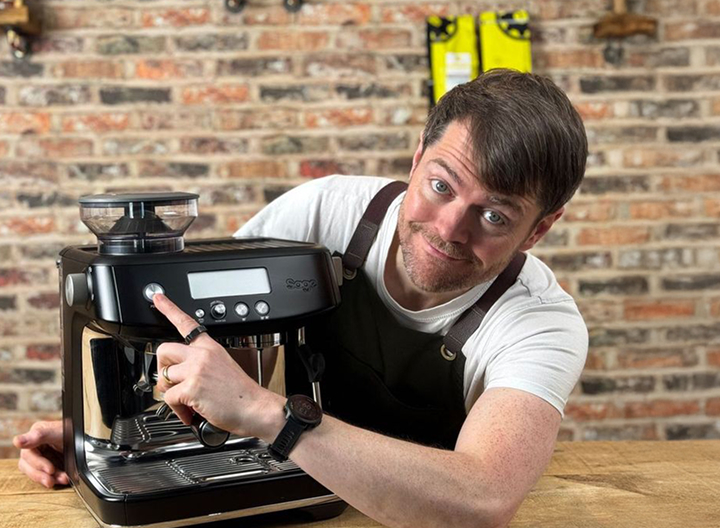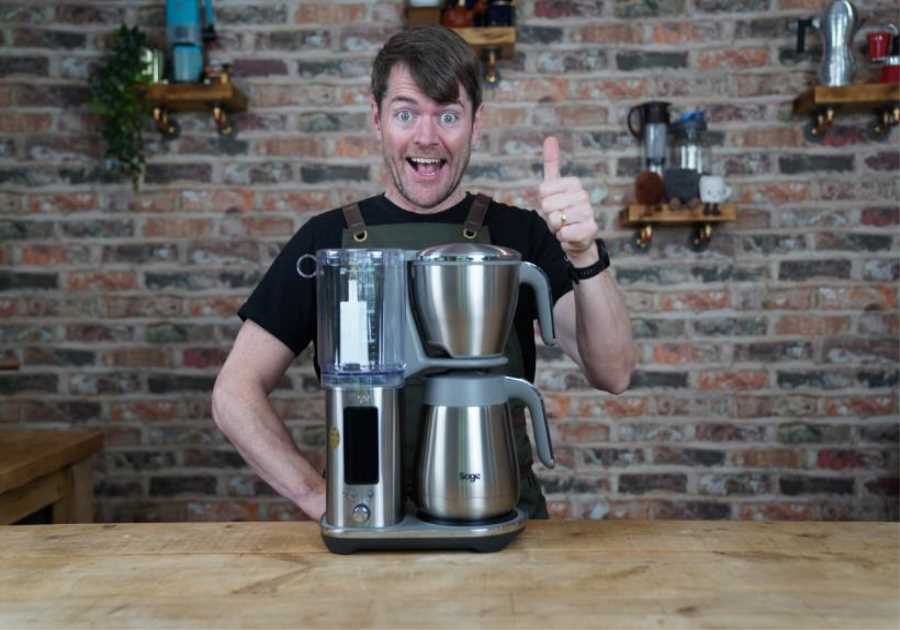The KitchenAid Espresso Machine 5KES6551 (catchy name, eh?) is KitchenAid’s new take on the integrated grinder espresso machine, clearly designed as a rival to the Sage Barista Express. It looks the part, it’s unusually quiet, and it comes in a nice range of colours, but how does it actually perform, and is it worth the price tag?
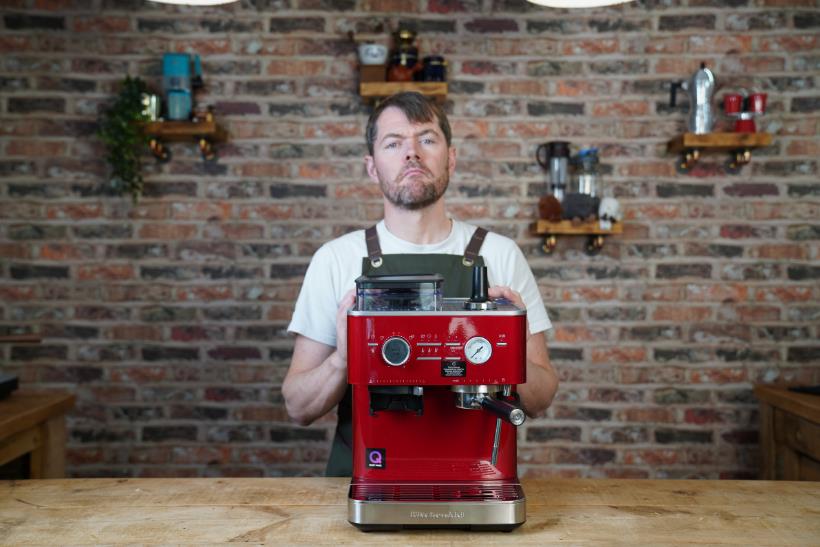
New here? I'm Kev, Coffee Kev to my mates. I'm a coffee machine fanatic who started doing this just over 10 years ago as a hobby. Amazingly, this is now my job ;-), I review coffee machines here at coffeeblog.co.uk, also on the Coffee Kev YouTube channel, and CoffeeKev.com for our cousins across the pond.
I'm also the director of coffee at Cworks.co.uk, where we supply mega-quality freshly roasted coffee beans. As I’m writing this, I’m sipping a flat white made with our Dark Chocolate & Hazelnut Brazil, which works really nicely on this machine for reasons I'll explain a bit later.
I spend time thoroughly testing the machines I review, and I produce 100% genuine, honest & independent reviews. I've never once taken money for a review, and I never will. As far as I'm concerned, I work for you, the reader, and it's my job to ensure you end up choosing the best coffee machine possible.
So, is the KitchenAid 5KES6551 the best espresso machine for you, maybe even better than the Barista Express? Let's find out:
Quick Menu
- KitchenAid 5KES6551 Overview & Specs
- What is the KitchenAid 5KES6551?
- The Grinder
- Portafilter & Baskets
- The Steam Wand
- Hot Water
- Pre-infusion
- Temperature Settings
- Espresso Quality
- KitchenAid vs Sage Barista Express
- KitchenAid 5KES6551 Likes & Dislikes
- KitchenAid 5KES6551: Q&A
KitchenAid Espresso Machine Overview & Specs
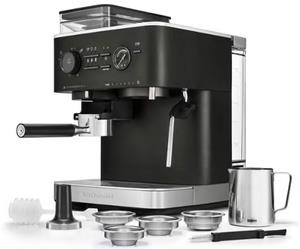
- Dimensions: 34.5 cm wide × 35.8 cm deep × 44.6 cm tall
- Heating System: Thermocoil
- Water Tank: 2.7 L (27 cm tall, metal handle)
- Max Cup Height: 13 cm
- Portafilter: 58 mm with pressurised & non-pressurised baskets
- PID Control: 3 brew temp settings
- Grinder: Integrated conical burrs, 15 external + 8 internal adjustments
- Hopper: 250 g, removable & lockable, spares available (£50)
- Ion Beam: Ioniser to reduce static in the grinder chute
- Shot Buttons: Single and double, timed.
- Steam Wand: Ball-jointed pro wand, non-removable tip
- Pressure Gauge: No bar markings, but 12 o’clock equals roughly 9 bars
- 3-way Solenoid Valve?: Multi-valve manifold (performs the same function as a 3-way solenoid)
- Colours: Porcelain White, Cast Iron Black, Brushed Stainless Steel, Juniper, Candy Apple Red
The KitchenAid Espresso Machine 5KES6551 Nutshell Review
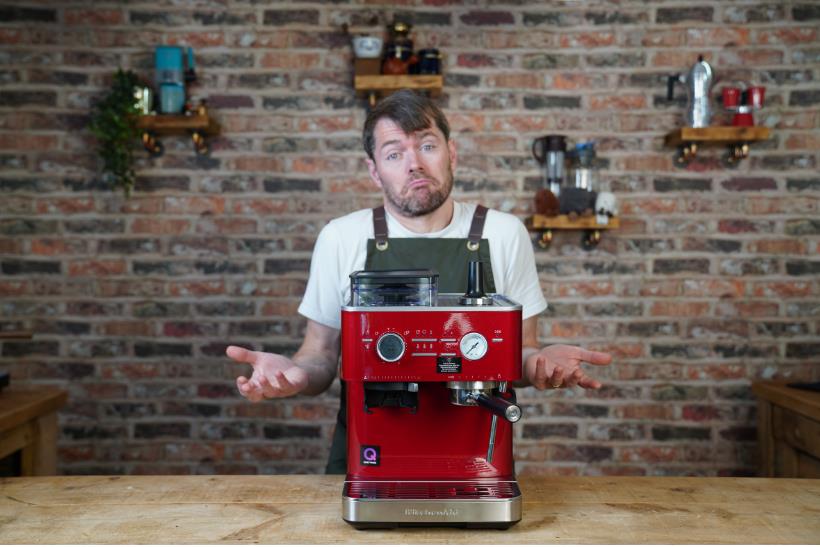
This is KitchenAid's answer to the Barista Express. It's more expensive, and it does have some pros vs the Barista Express, but none of them relate to cup quality.
If you love the KitchenAid brand and plan to use “normal” supermarket coffee beans, not freshly roasted beans, you might love the KitchenAid espresso machine.
It’s unusually quiet, comes in a range of modern colours, the grinder is tidy thanks to the ioniser, and the hopper is easy to remove and replace.
The portafilter feels solid and is flat-bottomed, making tamping slightly easier. The pressure gauge and respectable steam power add to the overall experience.
However, it falls short of the Barista Express in terms of espresso fundamentals required for using freshly roasted coffee beans, primarily due to the lack of a 9-bar OPV and a limited grind range.
In a nutshell, if you're more focused on design, colour choice & noise level, and especially if you really like the KitchenAid brand, this might tick the boxes for you. If you're mainly chasing the best cup quality possible at this price point (or slightly cheaper), then maybe not.
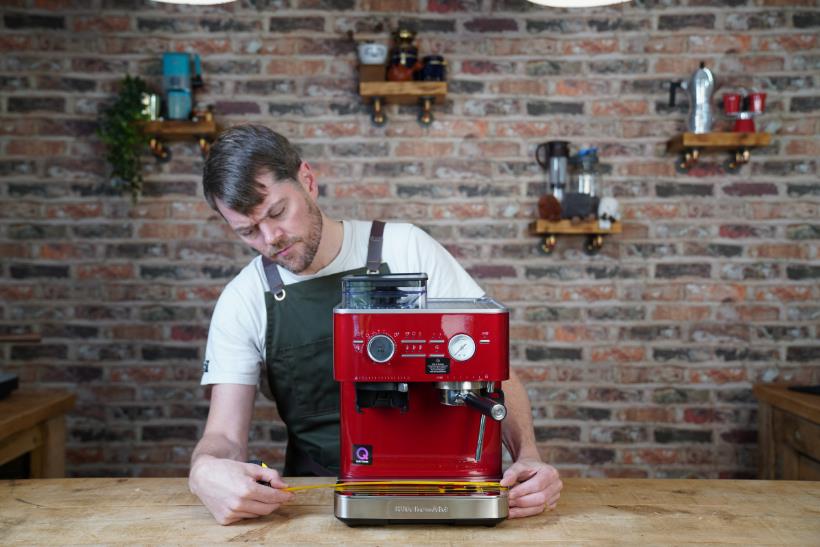
KitchenAid 5KES6551 Semi-Automatic Espresso Machine: Test Results
- Heat-up time: Roughly 50 seconds
- Espresso temperature: In-cup ~75-80°C, depending on brew temp & grind size
- Hot water temp: Around 65°C
- Hot water power: 160-170ml in ~50-55 seconds
- Steam-ready time: About 20 seconds
- Steam power: Takes roughly 1 minute 25 seconds to steam 170ml of milk to 60°C, including steam-ready time
- Shot ready time: Roughly 15 seconds after steaming milk
- Noise: Grinding ~60-64 dB, pump ~45-50 dB
The Integrated Grinder
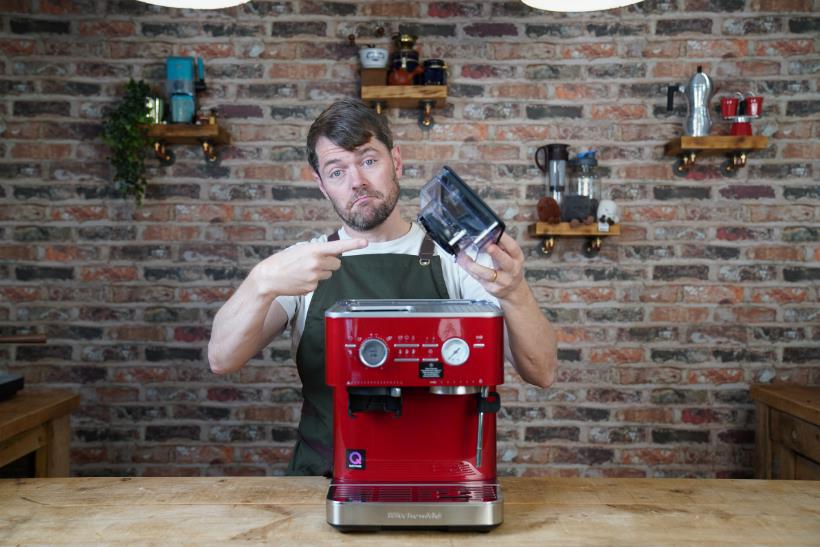
The KitchenAid semi-automatic espresso machine has a built-in grinder, with a removable hopper and removable burrs. The hopper can be removed easily, and a spare hopper is available for £50.
So far, so good. Being able to remove the hopper and the burrs to clean is great, and the hoppers are easier to remove than with the Sage Barista Express, as the large flat space around the burrs makes it easier to remove the beans that would block the hopper from being re-inserted (turn it off first). With the Barista Express, I usually have the Henry Hoover at the ready.
If you regularly switch beans, for example, from full caffeine to decaf or half caffeine, this machine is quite good for this, slightly better than the Barista Express in fact, simply because it's easier to remove the beans from the hopper cavity before locking the hopper back in place.
Quiet Grinding
This is one of the quietest grinders I've come across. It's certainly the quietest integrated grinder I've used, and it's noticeably quieter than the Barista Express, at around 60-65 dB. It sounds even quieter, though, as it makes a lower-pitched sound than normal.
Being quiet seems to be one of the main goals of KitchenAid with their coffee machines; they've clearly invested a lot in getting the Quiet Mark certification for this, as they've also done with their KF6 & KF7 bean-to-cup coffee machines, which are also very quiet.
It's worth noting that the loudest part of the process will always be knocking out the puck. Even with a super-quiet espresso machine, if people are sleeping, it's likely to be the banging of the portafilter that wakes them up.
Internal Grind Adjustment
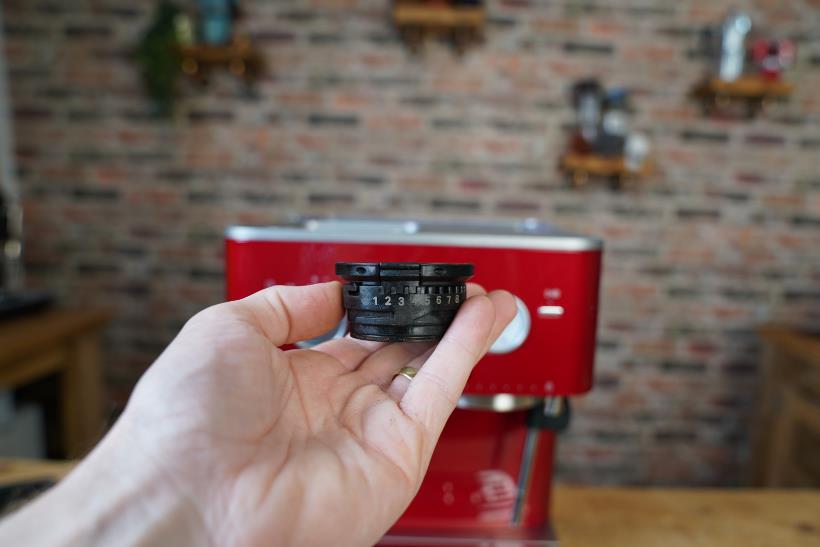
This is the first integrated grinder machine from any brand other than Sage to feature an adjustable internal grind adjustment. Unfortunately, though, all the available adjustments are coarser, not finer, which I don't understand.
Sage does this with their machines, allowing you to adjust the grind finer as the burrs wear, and also use it to calibrate. Sage machines come set to 6/10, and you can adjust either way.
There are 8 adjustments on the KitchenAid espresso machine, but both the first unit and the replacement unit (the first one wouldn't grind fine enough) came already set to the finest setting, so I'm slightly confused by that.
Grinding Range
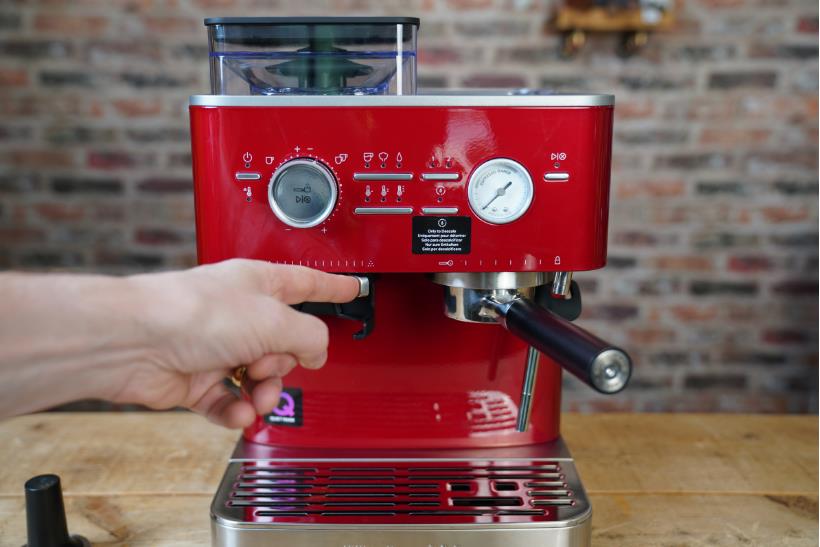
The first unit they sent was calibrated too coarsely. Even at the finest setting, I couldn't achieve a fine enough result with any coffee beans. They swapped it out, and the second loan unit is slightly better. I managed to dial in with Chocolate Brownie Blend at a 27-second shot, hitting 9 bars of pressure according to the gauge, but only at the absolute finest settings.
I suspect that anyone using freshly roasted coffee beans will find that they have issues grinding the beans to a fine enough consistency. If you want to dial in using fresh beans, you really need to stick to more porous beans that are easier to extract.
I've had the best results with Dark Chocolate & Hazelnut Brazil, and Chocolate Fondant Blend, and as I've mentioned, I did manage to get a good shot with my favourite, Chocolate Brownie Blend, but it was at the very finest setting.
Quirky Grind Timer
A few times, I pressed the grind button & nothing happened; I thought I'd broken another machine. I hadn't, it's just a weird quirk with this machine, you have to turn the timer dial so the mark perfectly aligns with one of the timer dots, if you're in between two dots, it won't grind.
Portafilter & Baskets
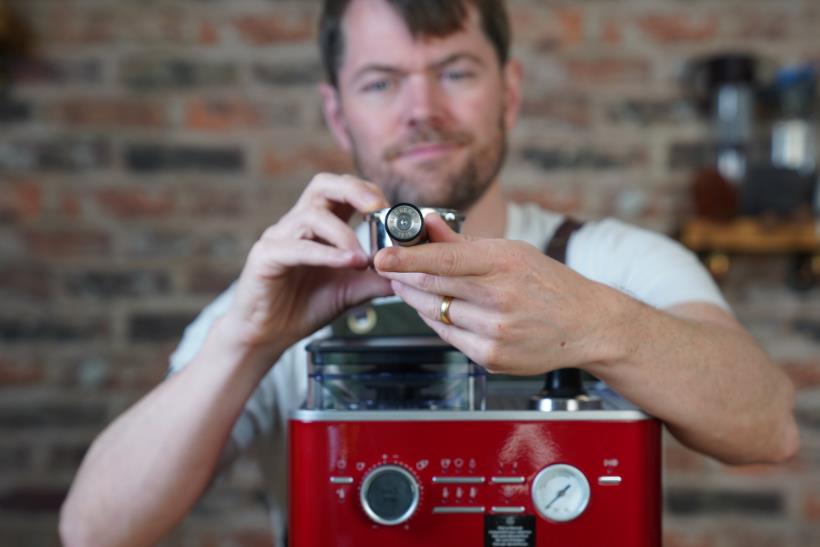
- 58mm portafilter – Solid heavy-weight, flat-bottomed
- Single & double shot, standard and pressurised
- Plastic internals & spouts
It’s a commercial-sized 58mm portafilter, which is good when it comes to sourcing aftermarket accessories, tampers, baskets, distribution tools and so on, and I was very impressed with it until I turned it over to see the plastic nozzles.
It's great, it's heavyweight and it's really unique, I've never seen a portafilter that looks quite like this before. It's flat-bottomed, which means you can tamp on a flat surface instead of having to rest it on the edge of the kitchen counter, and it makes it easier to put on scales.
I just don't like the little plastic nozzles, they could have done something similar to what Ninja have done with the Ninja Luxe portafilter to build in a metal splitter but keep it flat & balanced.
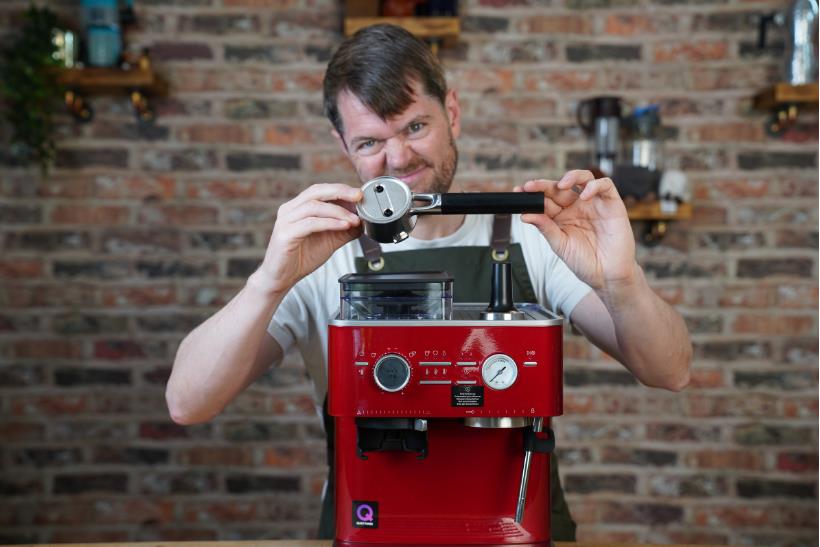
The plastic internal piece does make sense; it stops the metal portafilter from acting as a heatsink, and it means pre-heating the portafilter isn't as important, but still, I'd rather not have the plastic nozzles.
KitchenAid Espresso Machine Hot Water & Steam
The Steam Wand
- Pro steam wand, single hole tip (not removable)
- Ball jointed, flexible
- Long enough to ghost-steam

The steam wand is OK, in terms of power, it's very close to the power of the Barista Express, and it's flexible enough and long enough to allow you to ‘ghost steam'. This means hands-free steaming, while you look for your car keys or continue burning your toast, or whatever your morning ritual is.
I think not making the steam tip removable is an interesting decision. It's usual to be able to remove the tip so you can deep clean it. I'd recommend regular wand cleaning with the KitchenAid, by dissolving some Puly Caff in hot water, and then leaving the wand in the solution for 5-10 minutes, before steaming a couple of jugs of hot water to rinse.
Hot Water
- Max delivery 160-170ml
- On the cool side
The KitchenAid espresso machine does have a dedicated hot water spout, but my usual test to discover the time taken to dispense 200ml of hot water didn't work, as it maxed out at about 160ml. I've tested it several times, and it's usually between 160-170ml, and takes about 50-55 seconds to dispense.
The hot water temperature starts off promising, in the high 80s, but rapidly drops to the mid 60s, and the final 160-170ml of hot water ends up around the mid 60s, a bit on the cool side even for Americano, way too cold for tea.
KitchenAid 5KES6551 Espresso-Making
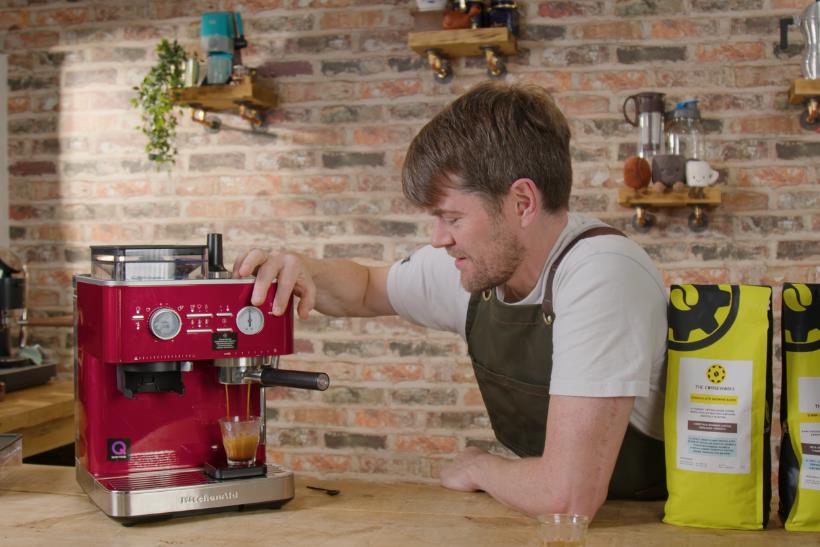
Timed Shot Buttons
- Single shot & double shot
- Timed, not volumetric
The KitchenAid semi-automatic espresso machine has timed shot buttons, like the Sage Barista Touch, not volumetric buttons like the Barista Express.
This means that if you set the double-shot button to 30 seconds, for example, the total time it'll run the pump for is 30 seconds. You'll receive a volume of espresso within this time frame, which will vary depending on the coffee used, the grind size, and the amount of moisture retained by the grounds.
Whether timed or volumetric doesn't really matter, as long as you know how much espresso you're getting in both cases, this is the key. Just get some scales, any will do, as long as you can set your shot buttons so that you're getting the desired volume, depending on the recipe given by whoever you get your coffee beans from.
For all the cworks recipes, see: Kev's Brew Guides.
Pre-infusion
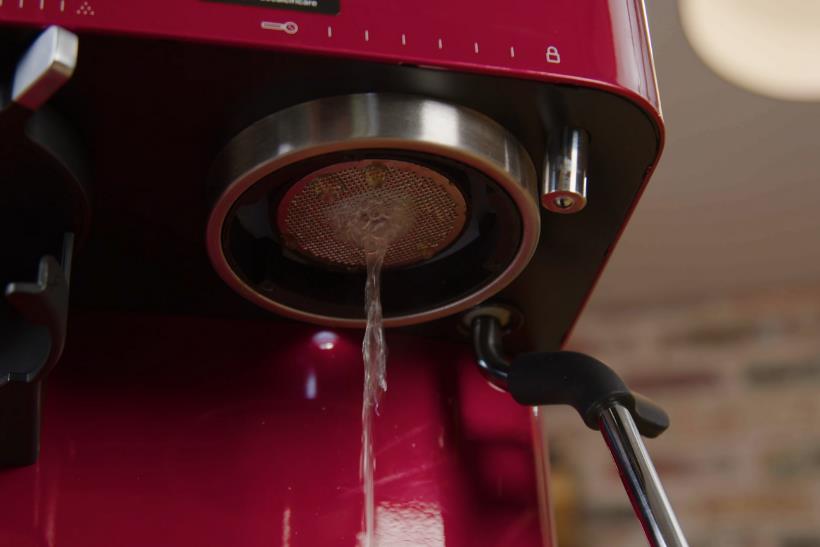
The preinfusion on the KitchenAid machine is a bloom type, or “pre-brew” type preinfusion, which means the pump runs at full flow rate, followed by a pause, and then runs again for the rest of the shot.
This is more or less the standard for preinfusion on entry-level espresso machines these days, and for me, this is more about marketing than anything else. Giving a machine a 2.5 second pump run time and a 2.5 second pause probably does more to sell espresso machines than it does to ensure good-tasting espresso.
I don't think it's a negative; I just don't believe it really does much other than give the brand the opportunity to harp on about “preinfusion”, which is a buzzword these days.
If you could control the pump run time and the pause time as you can with the Lelit Elizabeth, then I'd be impressed.
One of the impressive things about the Barista Express (all the Sage Espresso machines, in fact) is that it has pump power-controlled low-pressure preinfusion, which mimics “true” pre-infusion with plumbed-in commercial espresso machines.
Temperature Settings
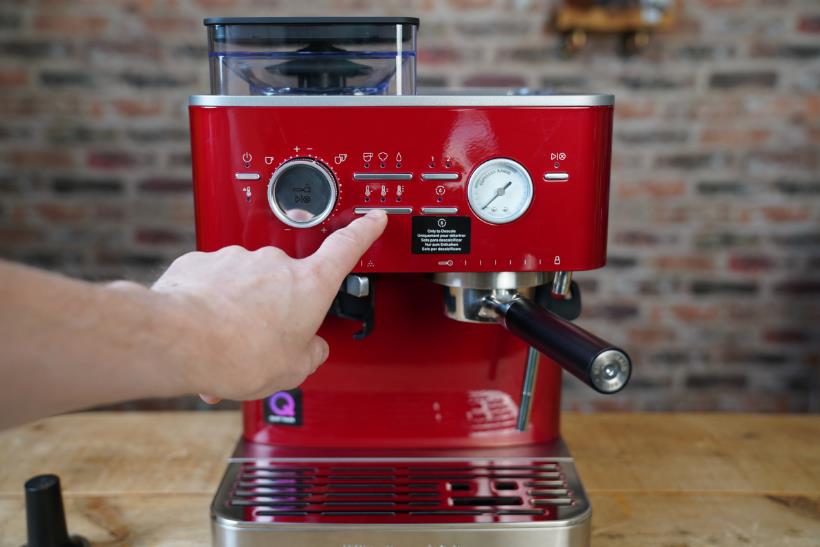
There are three brew temperature settings, low, medium & high, which translate roughly to:
- Low: ~90°C
- Medium: ~93°C
- High: ~96°C
I'd recommend sticking to the medium brew temperature with most beans. If you're using a very dark roast, you might find the low-temp setting to be more suitable. If you're struggling to dial in a slightly lighter roast bean, you might want to try the high-temp setting, although I do think getting anywhere near to being dialled in with anything lighter than medium/dark with this machine is going to be a real challenge, due to the grind size restriction.
Note: The Barista Express offers 5 temperature settings (91–95°C), compared with the KitchenAid’s 3.
Pressure Gauge
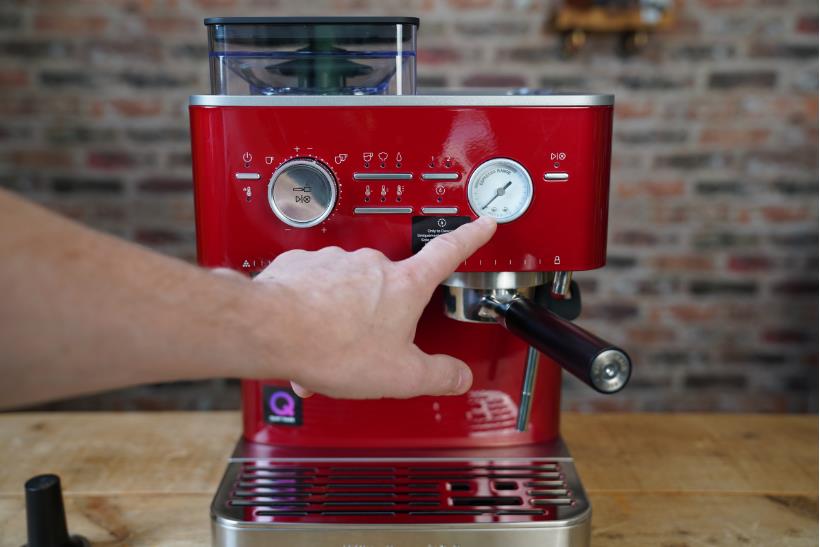
There is a pressure gauge, and like the Barista Express, it doesn't have any actual bar markings on it, which always annoys me ;-). Anyway, KitchenAid tell me that 9 bars is 12.00, as with the Barista Express.
This is fairly vague; we don't really know what the pressure is when the needle is at 12:00 on the dial, as with the Barista Express, but it does give you a heads up if you're miles away.
Dry Pucks
A 3-way solenoid valve is generally regarded as the best way to deal with ejecting excess moisture and pressure from the group after pulling shots, and machines with a 3-way solenoid have drier pucks that are more satisfying to knock out. It also means you don't have to wait a minute or two for the pressure to drop off before unlocking the portafilter if you grind too fine and “choke” the machine.
Solenoid machines also tend to have a less violent water flow from the shower screen than spring valve machines, so it's generally a good thing all round.
I was unclear on whether it has one, as it doesn't come with a backflush disk. KitchenAid told me it has what they refer to as a multi-valve manifold; a group of 2-way and 3-way solenoid valves.
It performs the same function, but via a slightly different approach. They stated that it doesn't require regular backflushing; however, if the user prefers to use a 58mm blind disk, they can backflush for deep cleaning.
Espresso Quality
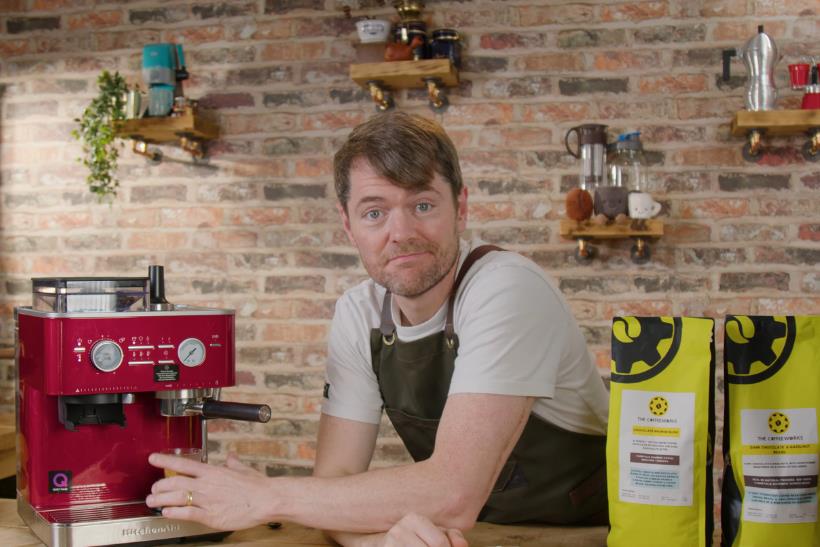
Espresso quality ultimately depends on the coffee beans you're using and how well-balanced the extraction is.
If you're using big brand or supermarket own-brand beans without a roasted-on date, I'd recommend simply using the pressurised baskets and don't worry too much about dialling in. These kinds of beans will essentially taste as they are, and if you like this type of coffee, you'll likely be very happy with the results you get when using the KitchenAid machine.
If you want to use freshly roasted coffee beans, so you can dial in using the standard non-pressurised baskets, the KitchenAid espresso machine is capable of pretty respectable espresso, with a relatively limited range of coffee beans.
I've had the best results with Dark Chocolate & Hazelnut Brazil, in terms of being dialled in and still having some finer adjustment available if needed. I managed to get dialled in with Chocolate Brownie Blend on the replacement unit, but it was at the very finest grind size.
2 Year Warranty, 10 Year Promise
One of the great things about KitchenAid products, at least in the UK, is that they offer decent peace of mind with their warranty.
It's a 2-year parts and labour warranty, which is standard, but they also offer a 10-year promise.
They guarantee that all the parts for your machine will be available for 10 years. So, if they discontinue a product, they must keep parts in stock for an additional 10 years to ensure they can repair any units purchased within that timeframe.
I wouldn't require something like this with a machine like the Sage Barista Express, which is one of the world's best-selling coffee machines, but I think it replaces the peace of mind that may be missing when buying a new machine with very little history.
Comparison: KitchenAid Espresso Machine Vs Sage Barista Express

When it comes to anything versus the Barista Express, the Barista Express usually wins. Typically, contenders compete on price but fall short in terms of fundamentals.
This is when we're talking straight comparisons. Many people ask about the Barista Express Vs Ninja Luxe Cafe, for example, and that's not a straight comparison at all. I can answer that question instantly, though.
If you could wave a magic wand and have a coffee shop in your kitchen, would it be a Starbucks with the full hot and cold drinks menu, or an indy coffee shop?
- Starbucks: Ninja Luxe
- Indy coffeeshop: Barista Express
Getting back to the Barista Express Vs KitchenAid question, though, the simple answer is that the Barista Express wins, unless you're a huge KitchenAid fan specifically wanting a KitchenAid espresso machine.
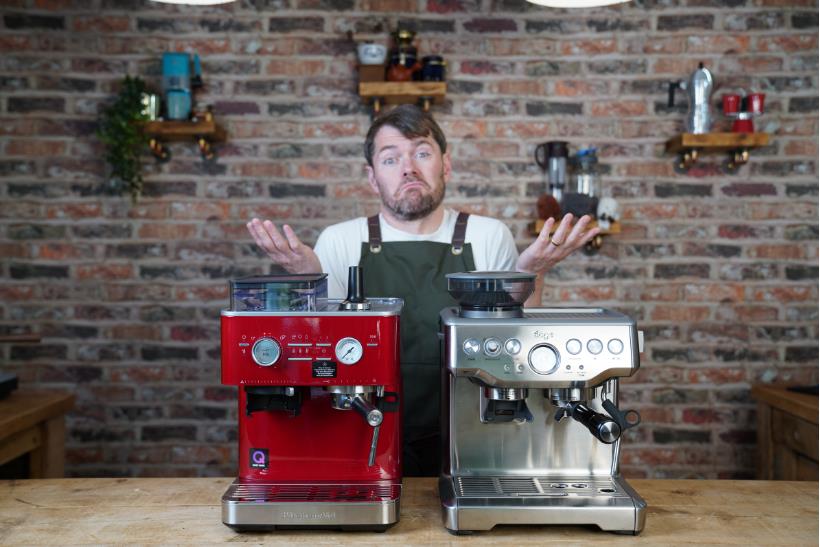
| Feature | KitchenAid | Sage Barista Express |
|---|---|---|
| External Grind Settings | 15 | 18 |
| Internal Grind Settings | 8 (comes set to 1) | 10 (comes set to 6) |
| Burrs | 38mm stainless steel burrs | 38mm Full-Nice stainless steel burrs |
| Water Tank | 2.7 L | 2.0 L |
| Ioniser | Yes (removes static from grounds) | No |
| Steam Wand | Non-removable tip | Removable tip |
| OPV | No (14 bar safety valve) | Yes (9 bar) |
| 3-Way Solenoid Valve? | No, multi-valve manifold (does the same job) | Yes |
| Portafilter | 58mm | 54mm |
| Noise | Grinding ~60-64 dB, pump ~45-50 dB | Grinding ~65-70 dB, pump ~55-60 dB |
| Hot Water Temp | ~65°C | ~80°C |
| Price | Check Price – Amazon | £629.99 (often on offer, and even better with a discount code) |
It's not all wins for the Barista Express, the KitchenAid does have quite a advantages over the Barista Express:
- Quieter: This is the quietest integrated grinder machine I've used so far, and it's definitely quieter than the Barista Express
- Easier hopper reinstallation: It's easier to replace the hopper after removing it than with the Barista Express, without the help of Henry Hoover.
- Colour choices: Some very nice, modern kitchen-friendly colours, vs just black or brushed stainless steel
- Water tank: It's bigger and feels slightly heavier-weight
- Cleaner grinding: Thanks to the ioniser, there's a very clean flow of grinds into the basket vs the Barista Express
The difference between the pros of the KitchenAid and the Pros of the Barista Express, though, is that all of the Pros for the Barista Express relate to cup quality:
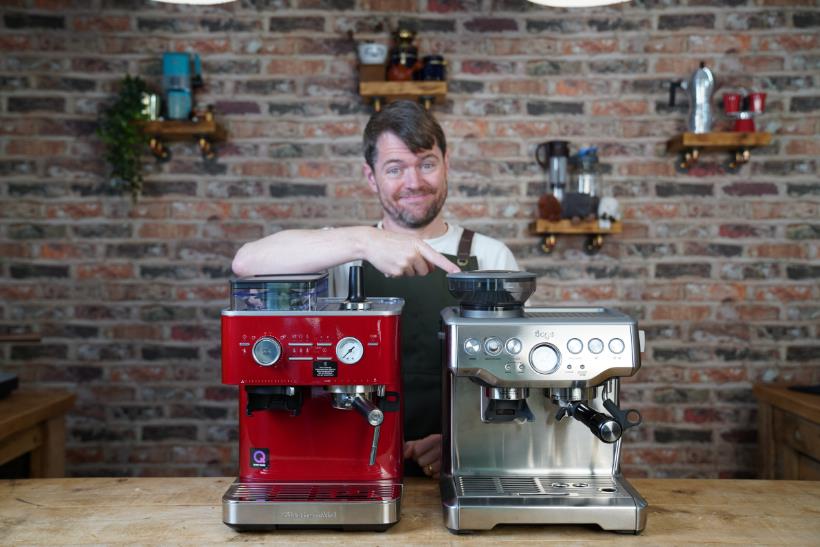
- More temperature settings: 5 temp settings from 91-95°C
- 9 Bar OPV: Limits the pressure in the basket to 9 bars for more balanced extraction
- Hotter hot water: Hot enough for Americano at least, and doesn't have the same 160-170ml limit.
- Grinds finer: At the factory pre-set, they usually grind fine enough; if not, you can simply calibrate finer
So if you're basing your choice mainly on the quality of the coffees you're likely to make with your new espresso machine, you'll probably choose the Barista Express. If you're more interested in design, in particular if you're really into the KitchenAid brand, and if noise level is really important, you might decide on the KitchenAid 5KES6551.
KitchenAid Espresso Machine Likes & Dislikes
What I Like Lots
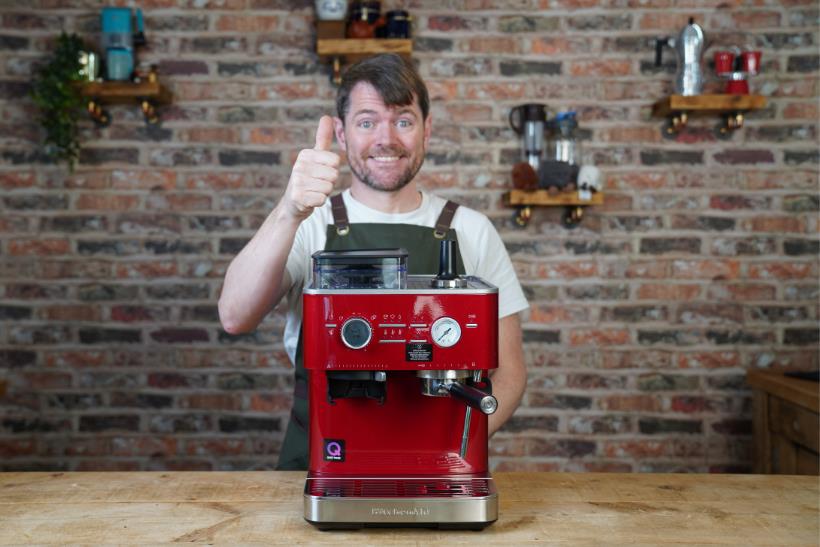
- Very quiet grinder, pleasant low pitch
- Stylish design, multiple colour choices
- Large 2.7 L tank with solid handle
- Clean grinder chamber, easy to swap beans
What I Like Less
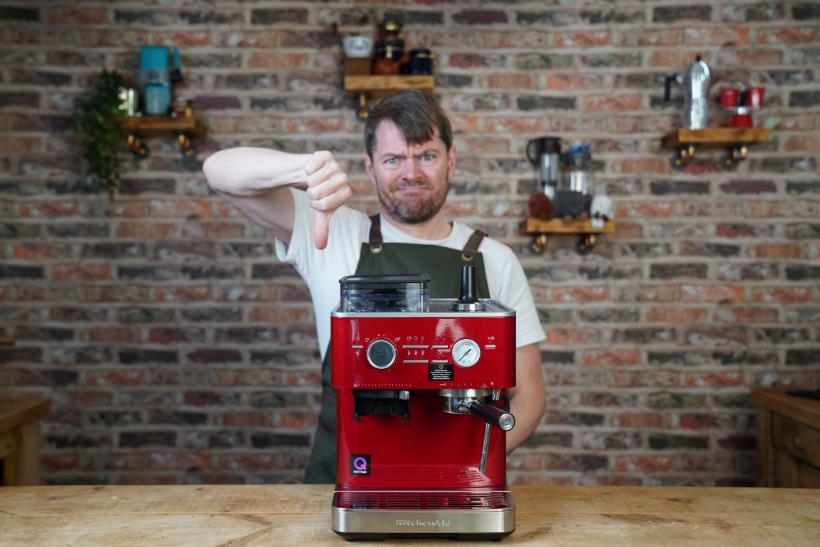
- No 9 bar OPV (14 bar safety valve only)
- Very limited grinding range
- Grind timer quirk (you have to line up the dial exactly with a dot)
- Weird internal adjustment, only goes coarser
- Hot water output tepid and limited to 160/170 ml
The other thing I don't like is the name. Come on KitchenAid, 5KES6551 ;-). That's fine as a model name or a SKU or whatever, but it's in need of a catchy name. For me, the no. 1 strength of this machine vs the Barista Express and other integrated grinder machines is how quiet it is. Maybe something like “The KitchenAid Whisper” or even “The Bawhisper Express”, hehe.
KitchenAid Espresso Machine: Final Verdict
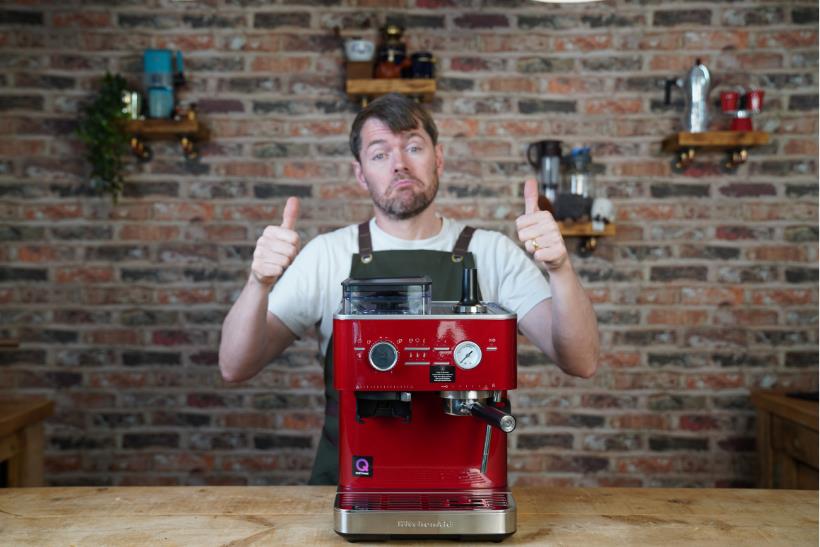
If you're a huge KitchenAid fan, and you really want a KitchenAid espresso machine, then you're not going to go far wrong with this machine. As long as you find coffee beans you're able to get good results with, and you're happy to stick to them, you'll get decent cup quality from the KitchenAid semi automatic espresso machine.
If you're not all that fussed about the brand, or the fact that it's quieter, and you're purely focusing on coffee quality, then I think the Barista Express is the best choice.
KitchenAid Espresso Machine FAQs:
Q: Does the KitchenAid espresso machine have a 9-bar OPV?
A: No, it has a safety valve, but no 9 bar OPV. You’ll need to rely on grind size and dose to control pressure.
Q: Can you backflush it?
A: You can, but KitchenAid don't seem to think it's crucial, they say it's something the user can do as part of deeper cleaning if they like. Personally, I would.
Q: How quiet is it really?
A: Grinding is about 60–64 dB, and the pump while brewing is only 45–50 dB. Noticeably quieter than most integrated machines. The grinder sounds quieter than this, too, as it makes a lower-pitched sound than grinders often do.
Q: What Makes the KitchenAid 5KES6551 Semi-Automatic?
A: Usually, semi-automatic just means the machine has a pump to create the pressure, instead of a lever. These days, though, brands like to make up their own terms for machines, and I think by “Semi-Automatic”, they're referring to the fact that it has a built-in grinder.
Q: Is KitchenAid 5KES6551 a bean-to-cup coffee machine?
A: The phrase “bean-to-cup” has become a grey area, some brands refer to integrated grinder espresso machines as “manual bean to cup coffee machines”, and to their true bean to cup machines (with a brewing unit and no portafilter) as automatic bean to cup coffee machines. This isn't a bean-to-cup coffee machine in the traditional sense, as it has a portafilter, but it does have a built-in grinder.
Q: Does the KitchenAid semi-automatic espresso machine work with light roasts?
A: I'd say no. To be fair, integrated grinder espresso machines aren't really designed for lighter roasts, and I'd give the same answer for the Sage Barista Express and Barista Pro. But one of the limitations of the KitchenAid espresso machine is that it doesn't grind particularly fine, so it's going to work better with darker roasts.
Q: Is the KitchenAid espresso machine better than the Sage Barista Express?
A: When it comes to the things that affect coffee quality, the answer would be no. There are things that are better than the Barista Express, it's quieter, the grinding is slightly cleaner, the water tank is bigger, it's available in a bigger colour range, but all the pros are not coffee-related, while all of the Barista Express's pros vs the KitchenAid relate to coffee quality.
The post KitchenAid Espresso Machine 2025 Review – A True Sage Barista Express Alternative? appeared first on Coffee Blog.
By: KevTitle: KitchenAid Espresso Machine 2025 Review – A True Sage Barista Express Alternative?
Sourced From: coffeeblog.co.uk/kitchenaid-espresso-machine/
Published Date: Sun, 31 Aug 2025 16:43:05 +0000

